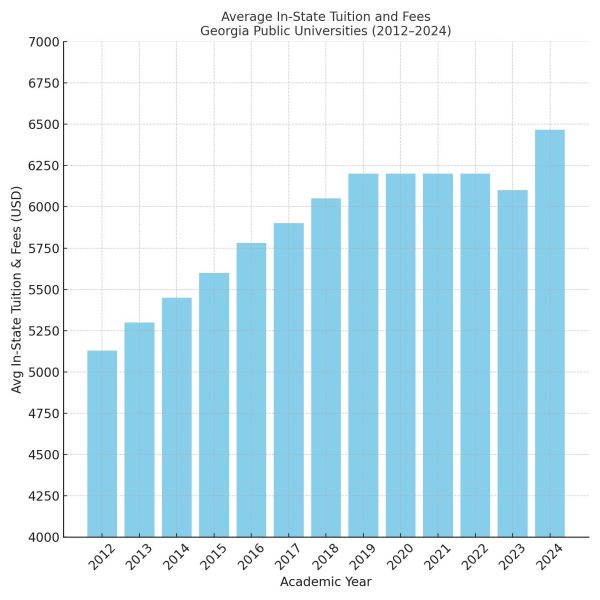
Georgia tuition rates during the fall 2025 semester have been announced, revealing the usual relatively stable rates, with out-of-state and international tuition rates slightly increasing at some institutions. Online and in-person semester-based fees will rise at certain Georgia institutions and will fall at others.
State legislatures at the University System of Georgia, or USG, have worked continuously to keep tuition affordable for undergraduate students in the state of Georgia by integrating scholarships, such as HOPE and Zell. These scholarships play a pivotal role in keeping higher education affordable for Georgians.
These efforts align with USG’s mission to ensure that higher education remains accessible to keep Georgia an educated state.
Public universities in the state receive state funding, which lowers tuition for in-state students. Out-of-state and international students do not contribute to the taxes being paid in the state and therefore, are met with higher tuition rates to offset their lack of contribution to the taxes.
Though most in-state undergraduate students will see no change in tuition, some institutions expect changes in other programs for the upcoming fall semester. According to USG, the 26 public colleges and universities will see a 2% increase in out-of-state tuition and a 3% increase for international students concerning undergraduate studies.
These changes reflect ongoing investments in campus facilities, student services and digital learning platforms, ensuring that colleges in Georgia maintain their standings as respectable academic institutions.
Students at the University of Georgia, or UGA, will have their overall fees rise from $708 to $729. Additionally, online undergraduate fees will go from $11 to $422.
“I attend in-person classes at UGA and the fee increase doesn’t seem like much of a difference to me,” said Helen McLaughlin, a junior psychology major at UGA. “When I look at other colleges outside of the state of Georgia, I honestly feel kind of bad because their tuition is so much higher than ours.”
McLaughlin emphasises how expensive it is to go to college in other states. Georgia works especially hard to keep tuition rates down, and even with a slight increase in fees, many students don’t see it as a very large obstacle, considering the circumstances of others.
Georgia State University is continuing to keep stable tuition and fee prices, aligning with the overall goal of the USG.
“Keeping tuition rates stable is a relief for my family and me,” said Keira Jones, a sophomore marketing major at Georgia State University. “It shows that the state is really prioritizing accessibility for education, and it gives students like me one less thing to stress about while focusing on our studies.”
This tuition stability ensures that students can focus on their academic goals, rather than financial burdens.
On the other hand, Georgia Institute of Technology is expected to raise its Master’s online tuition by 8%. Additionally, the online fees went from $107 to $440 per semester. This is the largest increase across the USG system for any program. Although these fees may be rising, Georgia Institute of Technology has some of the most affordable online programs in the country, highlighting Georgia’s dedication to affordable education.
Various other institutions, including the University of North Georgia, Clayton State University and Fort Valley, should expect to see fees rise as well.
Mandatory fees for students at Georgia College and State University, or GCSU, will be reduced slightly, allowing each student to save $2 every semester. Even though there are monetary savings at hand, there is still a conversation about how equitable tuition is in the state of Georgia.
“I don’t have the HOPE scholarship right now, and I’m experiencing a bit of trouble,” said Sarah Waldron, a sophomore sociology major at GCSU. “I don’t understand why the tuition prices make a difference based on scholarship. My family pays taxes and contributes the same amount as other people to the state.”
Waldron highlights her struggle, which many other students can relate to. She questions the fairness of tuition rates being influenced by scholarship eligibility, particularly when her family contributes equally to the state’s tax system. Her concern is parallel to how equitable it is for the financial burdens placed on students based on their academic experience.
As of now, Georgia tuition rates continue to stay moderately stable overall, with fee increases for certain programs at certain schools. As Georgia moves forward educationally, the tuition prices remind students and parents of the balance between affordability and the demands of a thriving education system.

